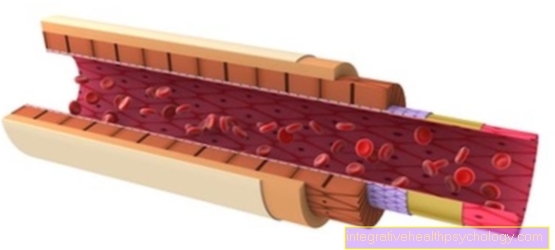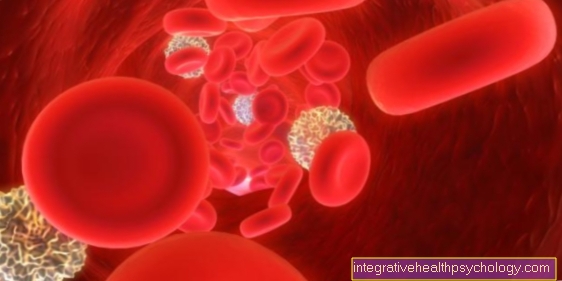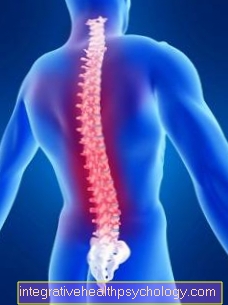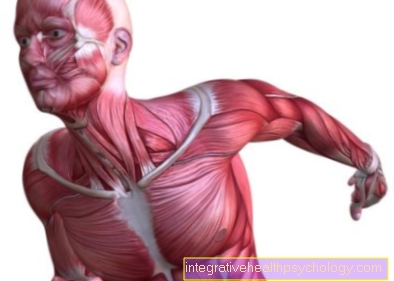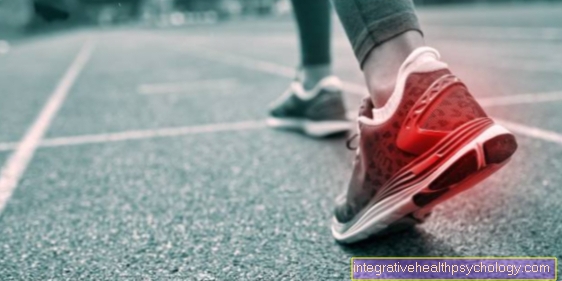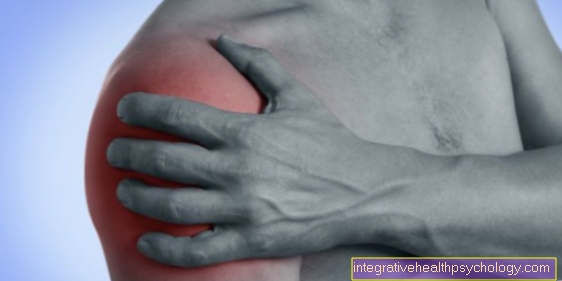Large adductor muscle (M. adductor magnus)
SynonymsLatin: Adductor magnus muscle
English: Adductor magnus muscle
definition
The adductor greater muscle is the largest muscle in the adductor group on the inside of the thigh. It runs from the middle lower edge of the pelvis (pubic bone and ischium) to the thighbone, where its attachment area extends over almost the entire length of the bone body. Adduction is the Latin word for attraction. The main task of the adductor large muscle is to bring the leg closer to the body. As a result, it has a stabilizing effect on many everyday movements, such as walking, but also during sporting activities, for example playing football.
course
Approach: The upper (proximal) fibers of the muscle attach to the roughening of the thighbone on its back (Linea aspera).
The lower (distal) fibers extend to the lower inner end of the thighbone, where they attach to a "bone hump". (Tuberculum adductorium)
Origin: Lower part of the Pubic bone (Ramus inferior ossis pubitis), as well as ischial tuberosity (Tuber ischiadicum)
Innervation: Obturator nerve (L2-L4) and Tibial nerve (L4-L5)
function
The great adductor muscle runs from top center front (Pubic bone / ischial tuberosity) obliquely outside bottom back. Its main function is to bring the thigh towards the middle of the body (Adduction). Due to its extensive approach to the thigh, however, it can also fulfill other functions. Its lower fibers, which start at the end of the thigh, cause the leg to stretch out when it contracts (Extension in the hip joint).
Since the muscle fibers of the muscle have two different approaches, it can be divided into two parts. One part starts higher up on the long tubular part of the thigh (Linea aspera), the other at the lower inner end of the thigh (tuberculum adductorium am Medial epicondyle). These two parts form a small gap, the so-called Hiatus tendineus. At this point the muscle, together with two other thigh muscles (M. adductor longus, M. vastus medialis) the Adductor canal (Canalis adductorius). This channel represents the point of passage of the large leg vessels (Femoral artery and the femoral vein) and the saphenous nerve. Thus, apart from its movement function, the great adductor muscle has an important anatomical importance.
common illnesses
Due to its importance for the adductor canal, as mentioned above, the great adductor muscle also plays a role in diseases involving this canal. The great leg artery running through the canal (Femoral artery) is often from arteriosclerotic Constrictions or occlusions affected. It is believed that the constriction of the adductor canal plays an important role in the development of this vascular disease.
Overloading can also lead to typical muscle injuries such as strain, Torn hamstring or more complete Muscle tear come. (Tendon) irritations can also occur.
Footballers in particular often complain about a "Adductor strain"This can affect the large adductor muscle, among other things. Footballers suffer this injury especially when passing or shooting with the inner instep, because the adductors are particularly stressed during this movement due to the outward-facing position of the leg.
Strengthening and stretching
There are two ways to stretch the inside of the thigh and thus stretch the adductor large muscle. The athlete is about in double shoulder width (Straddle step) and the tips of your feet point forward. The body weight is now shifted to one side so that the leg on the side to be stretched is almost fully stretched, while the other leg is bent in the knee joint. The upper body should be kept as straight as possible.
The second variant takes place while sitting. The soles of both feet touch while the knee joints are pushed towards the floor.
The large adductor muscle can be strengthened in the fitness studio on the equipment provided for this purpose ("adductor machine"). Here the leg is guided inwards against a counterweight or resistance.
Please also read our article on this Leg muscle training.
Synergists:
Adductors: Long adductor muscle (M. adductor longus), short adductor muscle (M. adductor brevis), Comb muscle (M. pectineus), Lean hamstrings (M. gracilis)
Antagonists:
Abductors: thigh ligament tensioners (M. tensor fasciae latae)glutes, small and medium muscles (Mm. Glutei minimus et medius)









